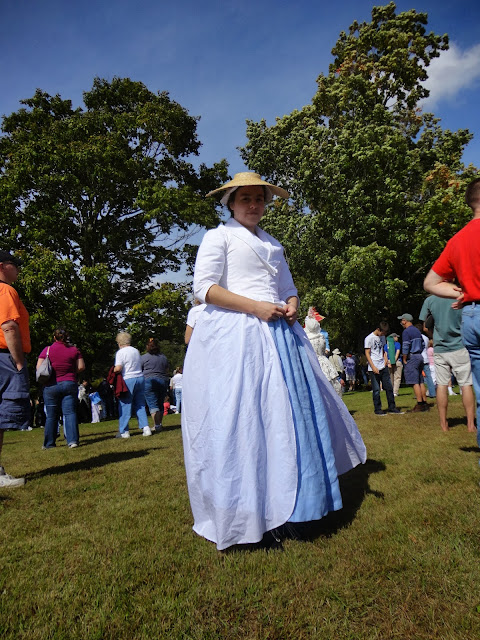White Muslin Gown, ca. 1780
 |
| Should have asked Mom to stand up to take the picture ... |
This is the first 18th century gown I've made since taking those many patterns for my book, and I think it's a great improvement over the blue linen one I made a few years ago. (The stays underneath are much better as well.)
I based this gown on the one pictured below, an anglaise with back pleats, a closed front, rounded skirt edges, and loops inside to pull it up (which I haven't put in yet but plan to eventually). It's also based in part on all the quotes about muslin gowns and silk coats, although this coat is linen.
 |
| Albany Institute of History and Art 1961.26.1a-b |
What I've Learned
- When scaling up an 18th century pattern, don't widen all the pieces in equal proportion. The back pieces barely need to be enlarged. Just because the dress form's shoulders are enormous doesn't mean that I need the straps to be out that far. (But once I fiddled a bit, I ended up with one strap in the exact right place and the other only out a bit too far, which is a huge improvement on my previous efforts - it's hard for me to get rid of preconceptions about where shoulder seams are supposed to go.)
 |
| Way too wide. |
- Allotting enough fabric for the pleats is very important, otherwise you end up with these tiny, tiny little pleats.
- I always have this weird thing about setting in 18th century sleeves, where I want them to be really pleated at the top. This is silly and I know it's silly because I've taken enough patterns to know that you don't need that! After taking out the pleats, I put it back on and tugged the sleeves up to fit more snugly. I could have actually cut them a little bit smaller.
 |
| No! When laid flat on a table, the sleeves should want to be out at right angles. |




Are you certain that your dress form is a woman dress form? Those shoulders look like they belong to a member of a men's crew team!
ReplyDeleteDear Cassidy,
ReplyDeleteWhat a refreshing post! Your fitting experiences are very real, and so very common among so many of us. What you have that we do not is first-hand knowledge of the original garments, so you know what might be at issue when the fit is not quite the way you want it. For example, knowing that laid flat, a sleeve set 18th century style would want to go straight out at right angles to the bodice. What a helpful piece of information.
Further, you're willing to admit that some things just have to wait, either for a better moment, or until next time. Ah, that makes me feel so much better. Sometimes after futzing around for ages I just have to say "okay, enough", and move on. (Hair, for example. Hair is my downfall.)
Anyhow, enjoyed the post, oh, and enjoyed seeing the rounded edges on your gown. What a pretty variation!
Very best,
Natalie